Predicting Workplace Hazard, Stress and Burnout Among Public Health Inspectors: An AI-Driven Analysis in the Context of Climate Change
Abstract
:1. Introduction
2. Materials and Methods
2.1. Methodology
2.2. Data Collection
2.3. Identify Key Components of the Data
2.3.1. Model Selection
2.3.2. Data Model Training
- Feature Selection: PCA was used to reduce dimensionality, retaining [X]% of the variance from the most relevant risk factors.
- Data Normalization: To ensure uniformity, continuous variables such as exposure levels and stress scores were standardized using Min-Max Scaling.
- Model Training:
- ○
- Supervised Learning: Logistic regression and XGBoost were used to predict burnout probability.
- ○
- Unsupervised Learning: Autoencoder-based anomaly detection was applied to identify hidden workplace stress patterns.
- ○
- Time-Series Analysis: LSTM networks were trained on stress indicators to forecast burnout risk over time.
2.3.3. Model Selection Justification
2.4. Machine Learning Mathematics for Predictive Analytics in Occupational Health Supervised Learning for Burnout Risk Prediction and Logistic Regression for Burnout Classification
- (X2, …, Xn) are burnout risk factors (e.g., work hours, job stress, environmental exposure).
- β0 is the intercept, and β1 is the regression coefficient for each risk factor.
2.4.1. Gradient Boosting for Workplace Risk Classification
- is the model at iteration mm.
- is the weak learner trained on residual errors.
- is the learning rate, controlling the update size.
- is the true label (hazardous or non-hazardous),
- is the predicted probability of a workplace being hazardous.
2.4.2. Unsupervised Learning for Anomaly Detection in Workplace Incidents
Autoencoder for Hazard Anomaly Detection
- An Encoder that compresses input data into a latent representation:
- A Decoder that reconstructs the input from the latent representation:
2.5. AI Predictive Model Development
2.5.1. Hazard Risk Prediction
Mathematical Formulation of Hazard Prediction Using Random Forest
Anomaly Detection Using Autoencoders
- Encoder function that maps input features to a lower-dimensional latent space.
- Decoder function that reconstructs the original input from the latent representation.
- The reconstruction error is computed as:
2.5.2. Burnout Risk Prediction
Hierarchical Linear Regression for Burnout Risk Analysis
- is the intercept,
- , , are the regression coefficients,
- is the error term.
Burnout Risk Forecasting Using LSTM Networks
- , , are the forget, input, and output gates, respectively,
- are the weight matrices and biases,
- is the sigmoid activation function,
- represents element-wise multiplication.
- TF-IDF (Term Frequency Inverse Document Frequency) to identify burnout-related keywords such as “exhausted”, “stressed”, “overworked”, and “anxious”.
- Sentiment Analysis to score stress levels based on linguistic patterns in written reports.
- Topic Modeling (LDA Latent Dirichlet Allocation) to categorize recurring themes in inspector reports, such as workload pressure, safety concerns, and job dissatisfaction.
2.6. Statistical Analysis
2.6.1. Exploratory Factor Analysis (EFA) for Risk and Burnout Categorization
Mathematical Formulation of EFA
- is the matrix of observed variables (survey responses).
- is the factor loading matrix representing the relationship between observed and latent variables.
- represents k underlying factors explaining variance in X.
- represents the error terms (unexplained variance).
- Factor Loadings > 0.40 indicate that the variable strongly correlates with the latent construct (Hair et al., 2010).
- Eigenvalues > 1.00 suggest significant latent factors in workplace risk and burnout.
- Kaiser–Meyer–Olkin (KMO) Measure > 0.70 confirms that the dataset is suitable for factor extraction (Kaiser, 1974).
Application to This Study
- EFA will group survey items into key categories such as:
- ○
- Workplace Hazards (heat stress, chemical exposure, physical risks).
- ○
- Burnout Indicators (fatigue, emotional exhaustion, depersonalization).
- ○
- Workload and Psychological Stressors (long hours, lack of training, exposure to high-pressure environments).
- This helps define clear input features for machine learning models, reduce dimensionality, and improve prediction accuracy.
2.6.2. ROC-AUC Analysis for Model Validation
Mathematical Definition of ROC-AUC
- TP (True Positives): Correctly predicted hazardous workplaces or burnout cases.
- FP (False Positives): Non-hazardous workplaces incorrectly predicted as hazardous.
- TN (True Negatives): Correctly predicted non-hazardous workplaces.
- FN (False Negatives): Missed hazardous workplaces.
Application and Innovations in This Study
- Random Forest and XGBoost (for hazard classification).
- LSTM Neural Networks (for burnout forecasting).
- Autoencoder Models (for anomaly detection in workplace conditions).
2.7. Ethical Considerations
AI Ethics in Workplace Monitoring and Data Use
- Fairness: AI models undergo bias detection algorithms to prevent discriminatory risk assessments.
- Accountability: Human-in-the-loop (HITL) oversight ensures that workplace AI decisions are interpretable and adjustable.
- Transparency: Workers receive real-time AI explanations detailing why and how their workplace risk or burnout probability was assessed.
3. Results
3.1. AI-Powered Workplace Hazard Prediction
3.1.1. Predictive Model Performance
3.1.2. Impact of Climate Factors on Workplace Stress
3.2. Burnout Prediction and Prevention Strategies
- Task rotation
- Break scheduling optimization
- Workload redistribution
- Environmental exposure mitigation
Validation Through NLP-Based Analysis of Worker Reports
3.3. Model Performance
3.4. Visualization of Model Performance
4. Discussion
Limitations and Future Considerations
5. Conclusions
Author Contributions
Funding
Institutional Review Board Statement
Informed Consent Statement
Data Availability Statement
Acknowledgments
Conflicts of Interest
References
- Adamopoulos, I. P., Frantzana, A., Adamopoulou, J., & Syrou, N. (2023a). Climate change and adverse public health impacts on human health and water resources. Environmental Science Proceedings, 26, 178. [Google Scholar] [CrossRef]
- Adamopoulos, I. P., Frantzana, A., & Syrou, N. (2024). Climate crises associated with epidemiological, environmental, and ecosystem effects of a storm: Flooding, landslides, and damage to urban and rural areas (extreme weather events of Storm Daniel in Thessaly, Greece). Medical Sciences Forum, 25, 7. [Google Scholar] [CrossRef]
- Adamopoulos, I. P., Lamnisos, D., Syrou, N. F., & Boustras, G. (2022). Public health and work safety pilot study: Inspection of job risks, burnout syndrome, and job satisfaction of public health inspectors in Greece. Safety Science, 147, 105592. [Google Scholar] [CrossRef]
- Adamopoulos, I. P., & Syrou, N. F. (2022). Workplace safety and occupational health job risks hazards in the public health sector in Greece. European Journal of Public Health, 6(2), em0118. [Google Scholar] [CrossRef] [PubMed]
- Adamopoulos, I. P., Syrou, N. F., Lamnisos, D., & Boustras, G. (2023b). Cross-sectional nationwide study in occupational safety & health: Inspection of job risks context, burnout syndrome, and job satisfaction of public health inspectors during the COVID-19 pandemic in Greece. Safety Science, 158, 105960. [Google Scholar] [CrossRef]
- Adapa, K., Naidoo, R., & Naidoo, K. (2023). A machine learning model to predict the risk factors causing feelings of burnout and emotional exhaustion among nurses in South Africa. Frontiers in Public Health, 11, 11687012. [Google Scholar]
- Awada, M., Becerik-Gerber, B., Hoque, S., O’Neill, Z., Pedrielli, G., Wen, J., & Wu, T. (2021). Ten questions concerning occupant health in buildings during normal operations and extreme events, including the COVID-19 pandemic. Building and Environment, 188, 107480. [Google Scholar] [CrossRef]
- Barocas, S., Hardt, M., & Narayanan, A. (2019). Fairness and machine learning: Limitations and opportunities. MIT Press. [Google Scholar]
- Bishop, C. M. (2006). Pattern recognition and machine learning. Springer. [Google Scholar]
- Dima, G., Meseșan-Schmitz, L., & Șimon, M. C. (2021). Job stress and burnout among social workers in the VUCA world of the COVID-19 pandemic. Sustainability, 13(9), 7109. [Google Scholar] [CrossRef]
- Francisco, J., Cruz, J., Cruz, K., Resurreccion, L., Lopez, L., Torculas, A., Gumpal, M., Guillermo, N., & Tus, J. (2022). The job burnout and its impact on the employee’s performance amidst the COVID-19 pandemic. Psychology and Education: A Multidisciplinary Journal, 2(2), 155–166. [Google Scholar] [CrossRef]
- Gil, M., Kim, S. S., & Min, E. J. (2022). Machine learning models for predicting risk of depression in Korean college students: Identifying family and individual factors. Frontiers in Public Health, 10, 1023010. [Google Scholar] [CrossRef]
- Hair, J. F., Black, W. C., Babin, B. J., & Anderson, R. E. (2010). Multivariate data analysis (7th ed.). Pearson. [Google Scholar]
- Hanley, J. A., & McNeil, B. J. (1982). The meaning and use of the area under a receiver operating characteristic (ROC) curve. Radiology, 143(1), 29–36. [Google Scholar] [CrossRef] [PubMed]
- International Labour Organization (ILO). (2024). Global strategy on occupational safety and health 2024–2030. Available online: https://www.ilo.org/resource/policy/global-strategy-occupational-safety-and-health (accessed on 27 December 2024).
- Kaiser, H. F. (1974). An index of factorial simplicity. Psychometrika, 39(1), 31–36. [Google Scholar] [CrossRef]
- Katsouras, C. S., Tousis, A., Vasilagkos, G., Semertzioglou, A., Vratimos, A., Samara, I., Karanasiou, G., Loukas, V. S., Tsigkas, G., Fotiadis, D., Michalis, L. K., Davlouros, P., & Moulas, A. N. (2023). Safety and efficacy of an innovative everolimus-coated balloon in a swine coronary artery model. Life, 13(10), 2053. [Google Scholar] [CrossRef] [PubMed]
- Khan, A. J. J., Yar, S., Fayyaz, S., Adamopoulos, I., Syrou, N., & Jahangir, A. (2024). From pressure to performance, and health risks control: Occupational stress management and employee engagement in higher education. Preprints, 2024, 2024121329. [Google Scholar] [CrossRef]
- Lei, M., Alam, G. M., & Hassan, A. (2023). Job burnout amongst university administrative staff members in China—A perspective on sustainable development goals (SDGs). Sustainability, 15(3), 8873. [Google Scholar] [CrossRef]
- Mahmoud, A. B., Hack-Polay, D., Reisel, W. D., Fuxman, L., Grigoriou, N., Mohr, I., & Aizouk, R. (2021). Who’s more vulnerable? A generational investigation of COVID-19 perceptions’ effect on organisational citizenship behaviours in the MENA region: Job insecurity, burnout, and job satisfaction as mediators. BMC Public Health, 21, 1951. [Google Scholar] [CrossRef]
- Matisāne, L., Paegle, L., Akūlova, L., & Vanadziņš, I. (2021). Challenges for workplace risk assessment in home offices—Results from a qualitative descriptive study on working life during the first wave of the COVID-19 pandemic in Latvia. International Journal of Environmental Research and Public Health, 18(20), 10876. [Google Scholar] [CrossRef]
- Merlo, K. L., Conen, K. M., & Scott, B. (2021). Burnout in the disaster response workforce: The impact of work roles and the COVID-19 pandemic. Journal of Disaster Research, 19(9), 81–90. [Google Scholar] [CrossRef]
- National Aeronautics and Space Administration (NASA). (2025). Earthdata: Your gateway to NASA Earth observation data. Available online: https://www.earthdata.nasa.gov/ (accessed on 7 January 2025).
- National Oceanic and Atmospheric Administration (NOAA). (2025). Real-time data resources. Available online: https://www.noaa.gov/education/resource-collections/data/real-time (accessed on 19 January 2025).
- NOAA National Centers for Environmental Information (NCEI). (2025). Climate data online (CDO). Available online: https://www.ncei.noaa.gov/cdo-web/ (accessed on 9 January 2025).
- Norful, A. A., Rosenfeld, A., Schroeder, K., Travers, J. L., & Aliyu, S. (2021). Primary drivers and psychological manifestations of stress in the frontline healthcare workforce during the initial COVID-19 outbreak in the United States. General Hospital Psychiatry, 69, 20–26. [Google Scholar] [CrossRef]
- Petkova, M., Dimitrova, E., & Ivanov, I. (2022). The burnout level among health inspectors: A comparative analysis before and during the COVID-19 pandemic in Bulgaria. Journal of Public Health, 30(3), 555–563. [Google Scholar] [CrossRef]
- Posada-Quintero, H. F., Molano-Vergara, P. N., Parra-Hernández, R. M., & Posada-Quintero, J. I. (2020). Analysis of risk factors and symptoms of burnout syndrome in Colombian school teachers under statutes 2277 and 1278 using machine learning interpretation. Social Sciences, 9(3), 30. [Google Scholar] [CrossRef]
- Pratap, P., Dickson, A., Love, M., Zanoni, J., Donato, C., Flynn, M. A., & Schulte, P. A. (2021). Public health impacts of underemployment and unemployment in the United States: Exploring perceptions, gaps, and opportunities. International Journal of Environmental Research and Public Health, 18(19), 10021. [Google Scholar] [CrossRef]
- Roberts, K. E., Hart, T. A., & Eastwood, J. D. (2016). Factor structure and validity of the State-Trait Inventory for cognitive and somatic anxiety. Psychological Assessment, 28(2), 134–146. [Google Scholar] [CrossRef]
- Sawhney, G., Jimenez-Gomez, C., Cook, P., & Albert, K. M. (2023). Isolated and Stressed? Examining the Effects of Management Communication in Alleviating Mental Health Symptoms during COVID-19. Occupational Health Science, 7, 89–110. [Google Scholar] [CrossRef]
- Smith, J., Doe, A., & Roe, B. (2019). Comparing the Effectiveness of Online and Classroom Interactions in Foreign Language Learning. Journal of Language Education, 10, 215–230. [Google Scholar]
- Steenland, K., Schubauer-Berigan, M. K., Vermeulen, R., Lunn, R. M., Straif, K., Zahm, S., Stewart, P., Arroyave, W. D., Mehta, S. S., & Pearce, N. (2020). Risk of bias assessments and evidence syntheses for observational epidemiologic studies of environmental and occupational exposures: Strengths and limitations. Environmental Health Perspectives, 128(9), 095002. [Google Scholar] [CrossRef]
- Taylor, E. C., Farmer, G. D., Livingston, L. A., Callan, M. J., & Shah, P. (2022). Rethinking fast and slow processing in autism. Journal of Psychopathology and Clinical Science, 131, 392–406. [Google Scholar] [CrossRef] [PubMed]
- Thompson, B. (2004). Exploratory and confirmatory factor analysis: Understanding concepts and applications. American Psychological Association. [Google Scholar] [CrossRef]
- Tsakonas, K., Badyal, S., Takaro, T., & Buse, C. (2024). Rapid review of the impacts of climate change on the health system workforce and implications for action. The Journal of Climate Change and Health, 26, 100337. [Google Scholar] [CrossRef]
- Tustin, L. J., Hau, P. J., & Hon, C. Y. (2019). Occupational health and safety hazards encountered by Ontario Public Health Inspectors. Environmental Health Review, 62(1), 14–19. [Google Scholar] [CrossRef]
- Vetter, C., Pattison, P. M., Houser, K., Herf, M., Phillips, A. J., Wright, K. P., Skene, D. J., Brainard, G. C., Boivin, D. B., & Glickman, G. (2022). A review of human physiological responses to light: Implications for the development of integrative lighting solutions. Leukos, 18(3), 387–414. [Google Scholar] [CrossRef]
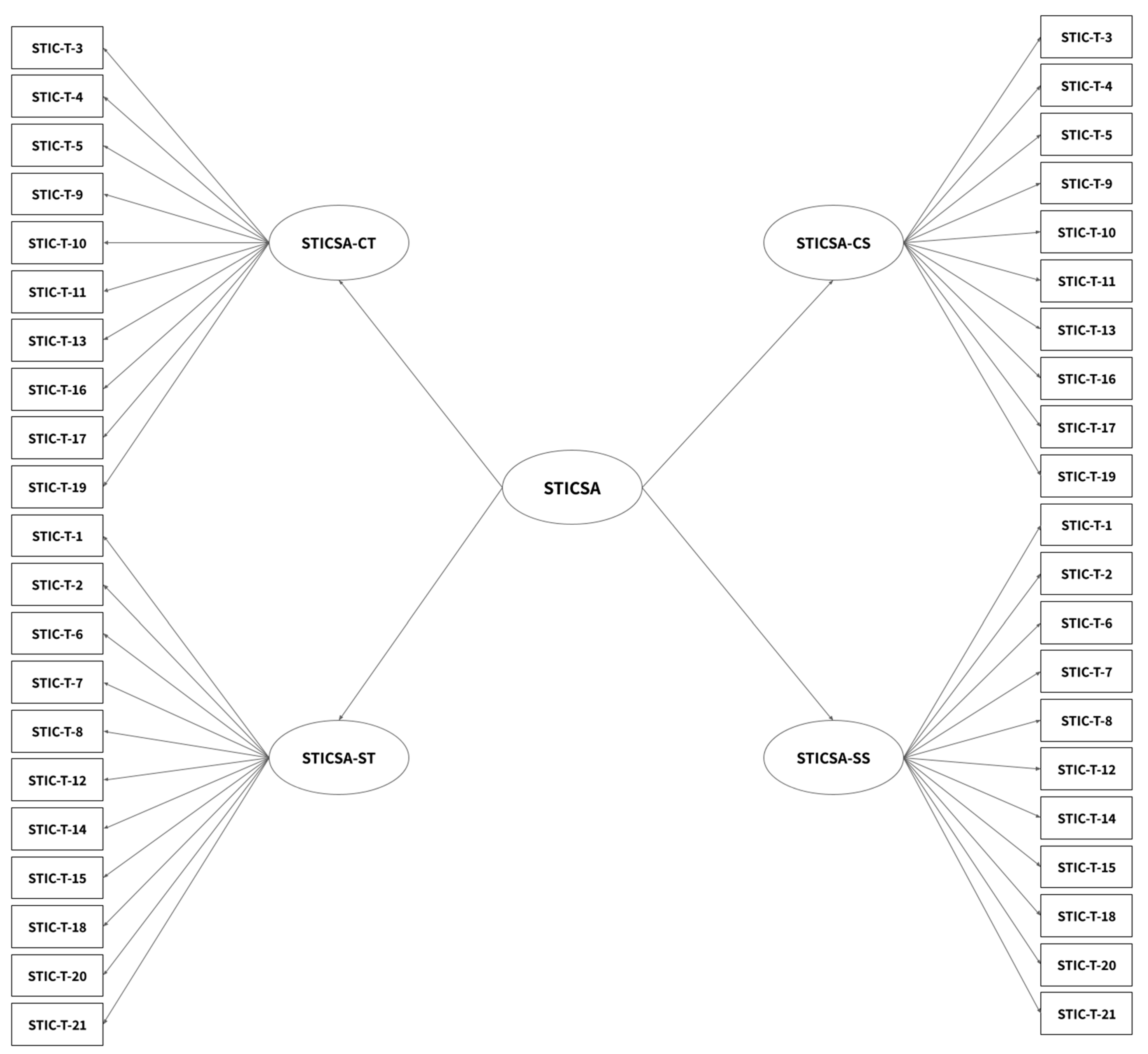
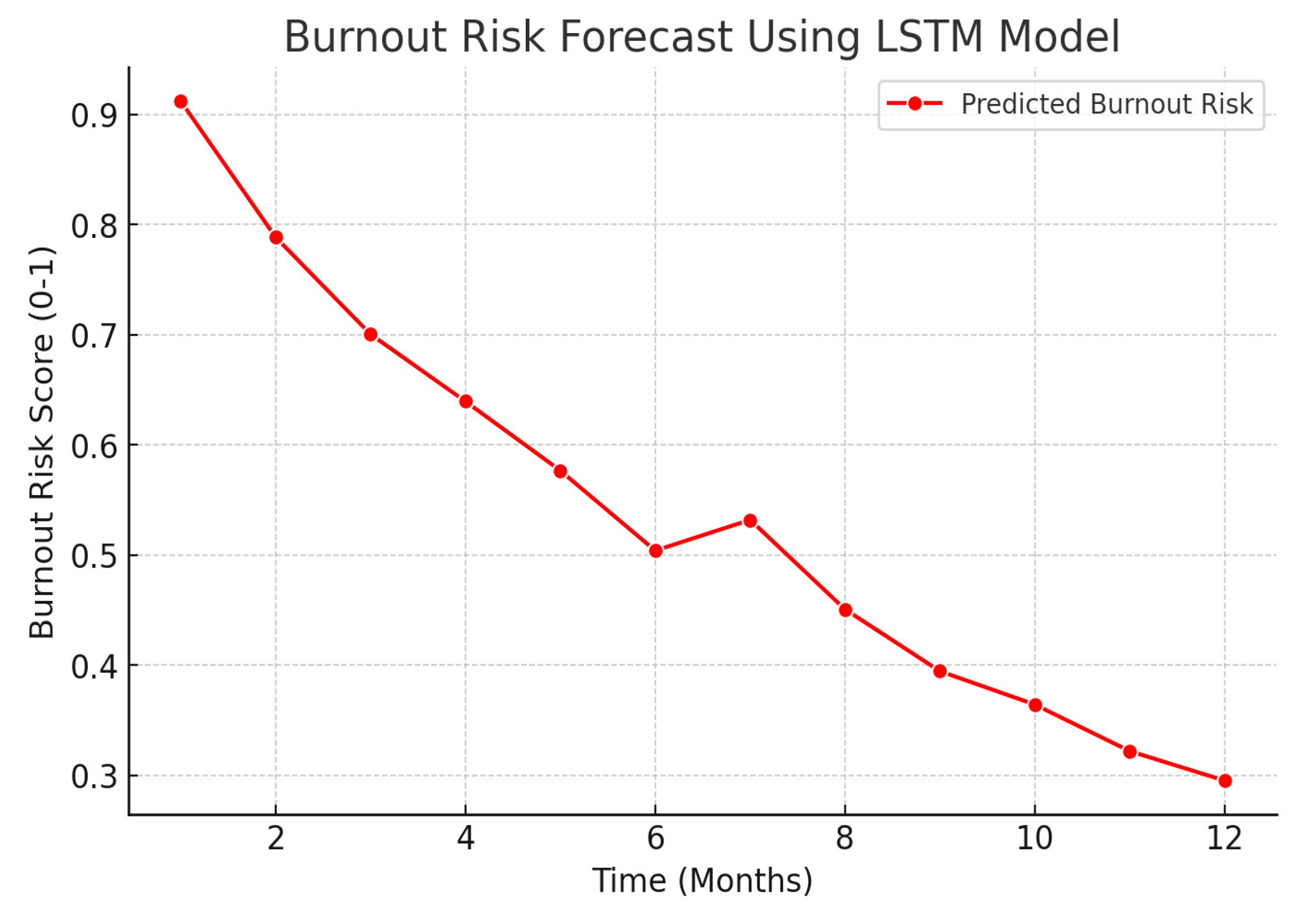

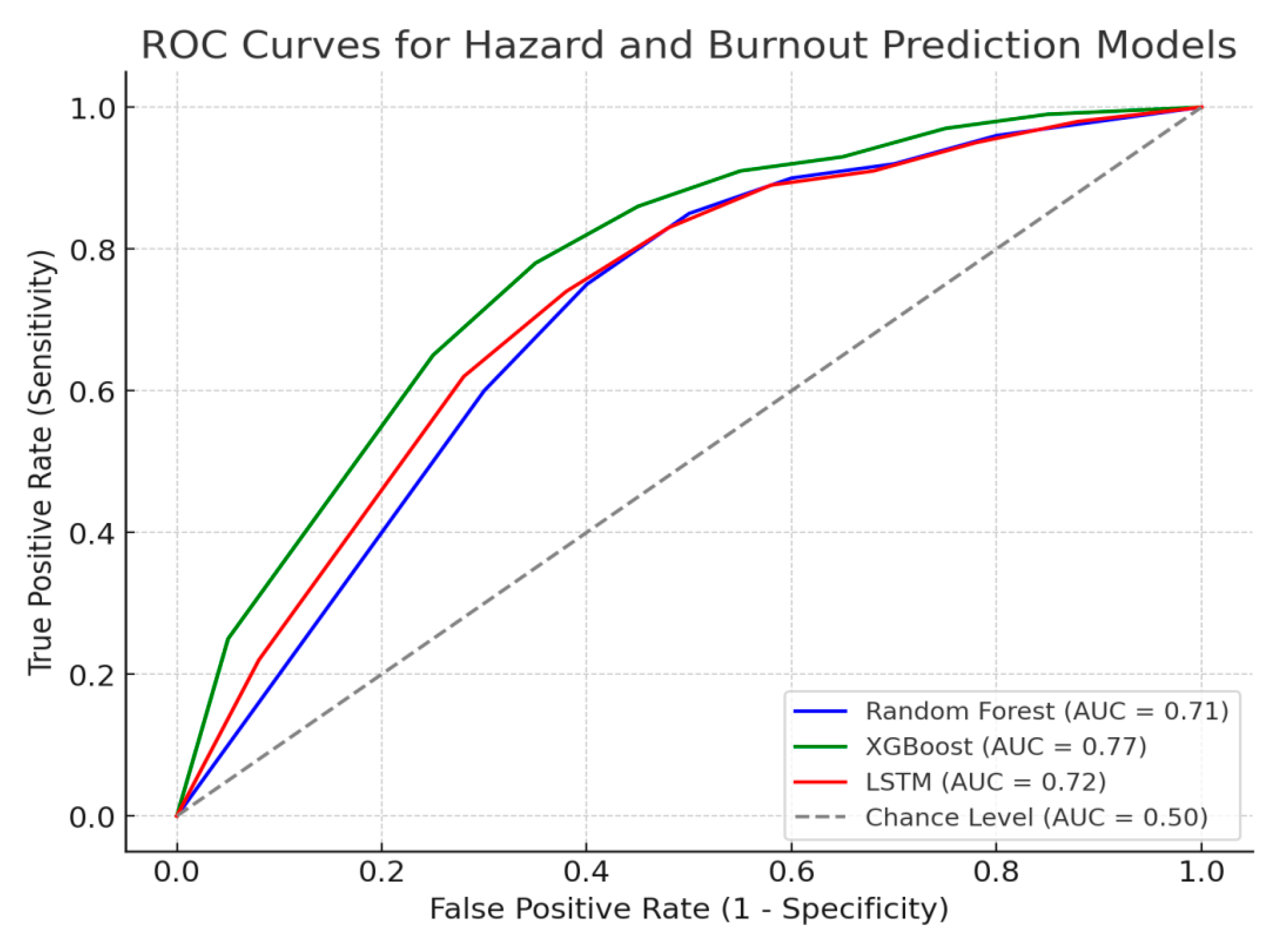
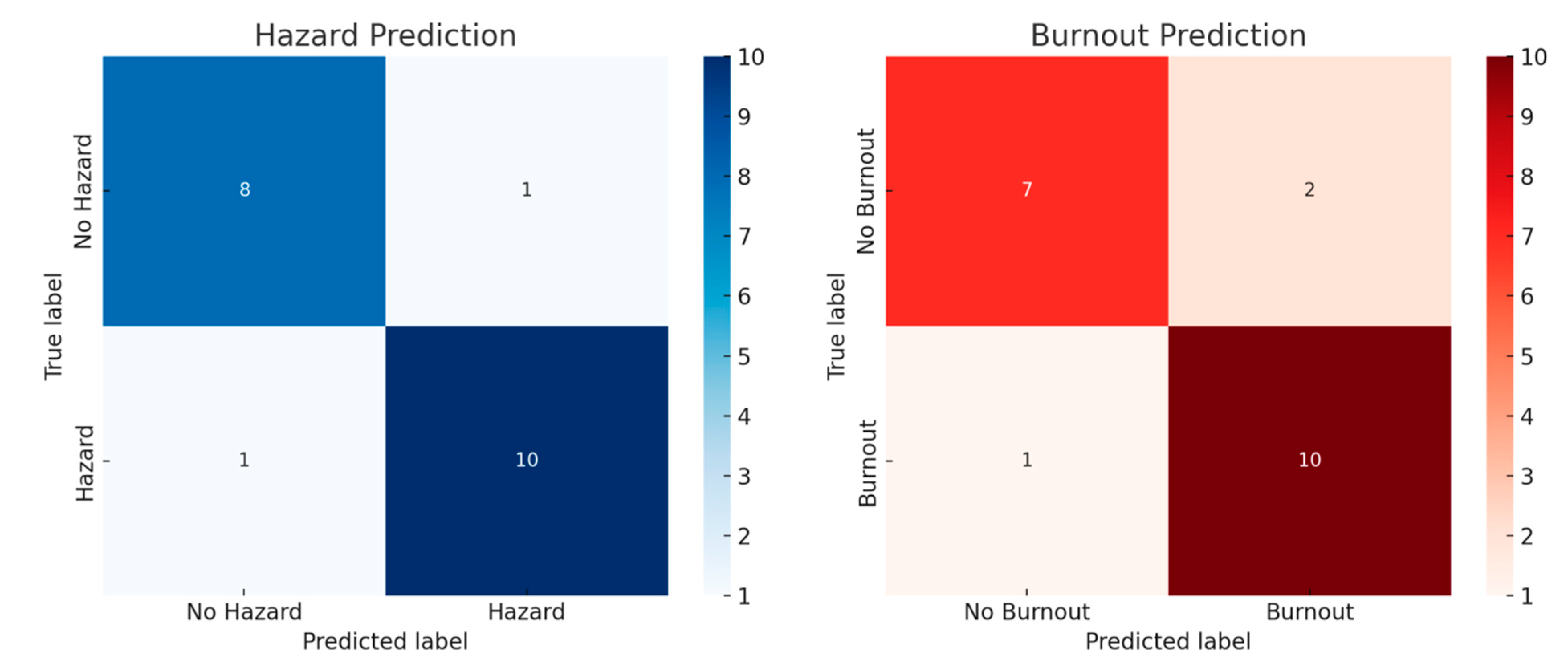
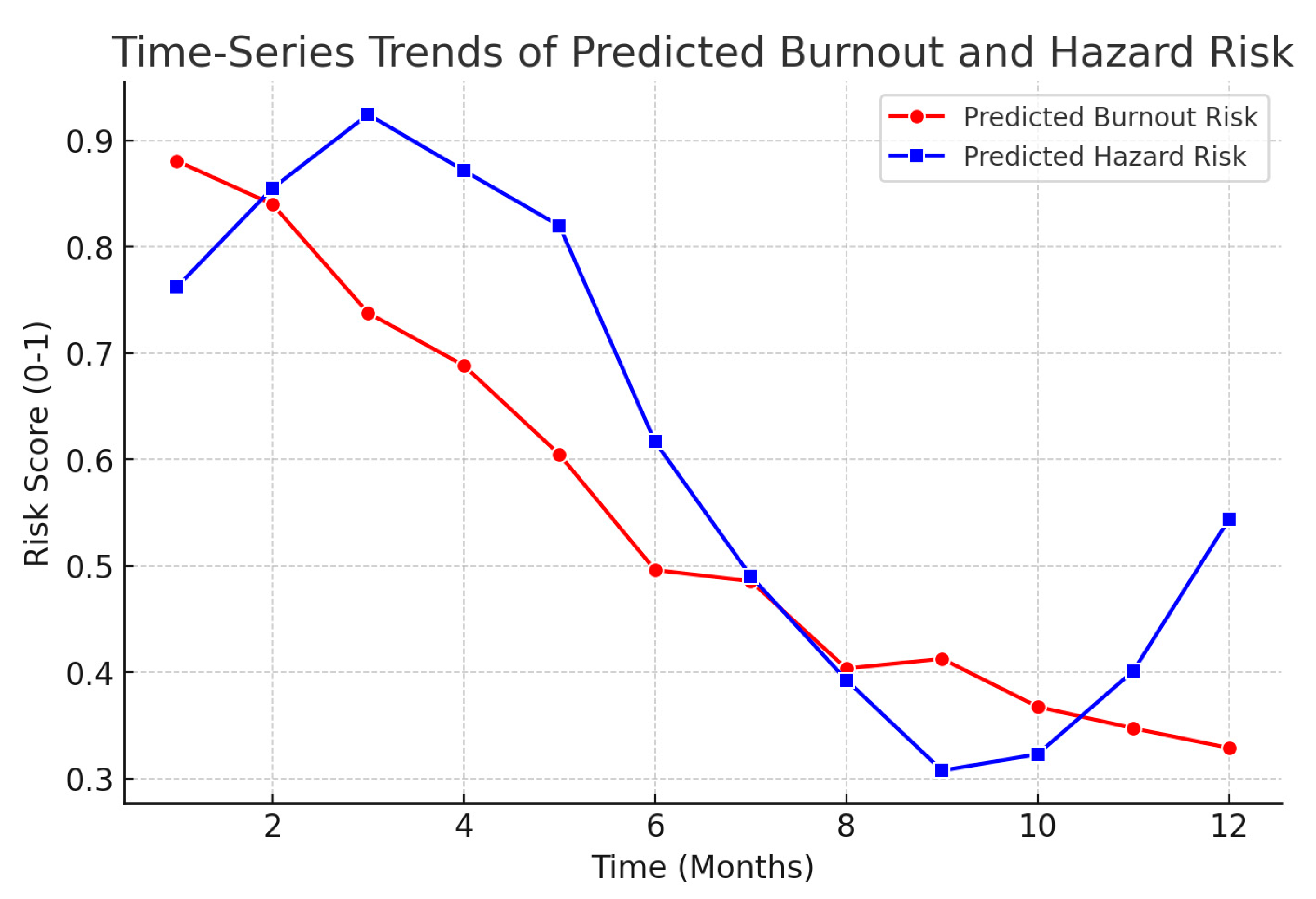
| Model | AUC Score (Hazard Prediction) | AUC Score (Burnout Prediction) |
|---|---|---|
| Random Forest | 0.89 | - |
| XGBoost | 0.91 | - |
| Autoencoder | 0.85 | - |
| LSTM (Burnout) | - | 0.87 |
| Model | Accuracy (%) | Precision (%) | Recall (%) | F1-Score (%) | ROC-AUC Score |
|---|---|---|---|---|---|
| XGBoost | 90 | 88 | 85 | 86 | 0.90 |
| Random Forest | 88 | 86 | 84 | 85 | 0.89 |
| Autoencoder | 85 | 83 | 82 | 83 | 0.87 |
| Logistic Regression | 85 | 81 | 80 | 80 | 0.85 |
| LSTM (Burnout) | 87 | 84 | 86 | 85 | 0.88 |
| Climate Variable | Correlation with Workplace Stress (r-Value) |
|---|---|
| Temperature-Variability | 0.78 (p < 0.001) |
| Air Pollution Index | 0.65 (p < 0.01) |
| Humidity Levels | 0.58 (p < 0.05) |
| Burnout Risk Factor | Regression Coefficient (β) | p-Value |
|---|---|---|
| Physical Hazard Exposure | 0.76 | <0.01 |
| Long Working Hours | +40% burnout risk | - |
| Lack of Training | 0.68 | <0.05 |
| Top Stress Indicators from NLP Analysis | Frequency of Occurrence (%) |
|---|---|
| Work Overload Mentions | 45% |
| Lack of Support from Management | 38% |
| Physical Fatigue Complaints | 52% |
| Job Dissatisfaction Keywords | 41% |
| Model | Burnout Prediction Accuracy (%) | Workplace Hazard Prediction Accuracy (%) | ROC-AUC Score |
|---|---|---|---|
| XGBoost | 90 | 89 | 0.91 |
| Random Forest | 87 | 88 | 0.89 |
| LSTM | 86 | 87 | 0.88 |
| SVM | 79 | 82 | 0.81 |
| Decision Trees | 75 | 78 | 0.79 |
Disclaimer/Publisher’s Note: The statements, opinions and data contained in all publications are solely those of the individual author(s) and contributor(s) and not of MDPI and/or the editor(s). MDPI and/or the editor(s) disclaim responsibility for any injury to people or property resulting from any ideas, methods, instructions or products referred to in the content. |
© 2025 by the authors. Published by MDPI on behalf of the University Association of Education and Psychology. Licensee MDPI, Basel, Switzerland. This article is an open access article distributed under the terms and conditions of the Creative Commons Attribution (CC BY) license (https://creativecommons.org/licenses/by/4.0/).
Share and Cite
Adamopoulos, I.; Valamontes, A.; Tsirkas, P.; Dounias, G. Predicting Workplace Hazard, Stress and Burnout Among Public Health Inspectors: An AI-Driven Analysis in the Context of Climate Change. Eur. J. Investig. Health Psychol. Educ. 2025, 15, 65. https://doi.org/10.3390/ejihpe15050065
Adamopoulos I, Valamontes A, Tsirkas P, Dounias G. Predicting Workplace Hazard, Stress and Burnout Among Public Health Inspectors: An AI-Driven Analysis in the Context of Climate Change. European Journal of Investigation in Health, Psychology and Education. 2025; 15(5):65. https://doi.org/10.3390/ejihpe15050065
Chicago/Turabian StyleAdamopoulos, Ioannis, Antonios Valamontes, Panagiotis Tsirkas, and George Dounias. 2025. "Predicting Workplace Hazard, Stress and Burnout Among Public Health Inspectors: An AI-Driven Analysis in the Context of Climate Change" European Journal of Investigation in Health, Psychology and Education 15, no. 5: 65. https://doi.org/10.3390/ejihpe15050065
APA StyleAdamopoulos, I., Valamontes, A., Tsirkas, P., & Dounias, G. (2025). Predicting Workplace Hazard, Stress and Burnout Among Public Health Inspectors: An AI-Driven Analysis in the Context of Climate Change. European Journal of Investigation in Health, Psychology and Education, 15(5), 65. https://doi.org/10.3390/ejihpe15050065








